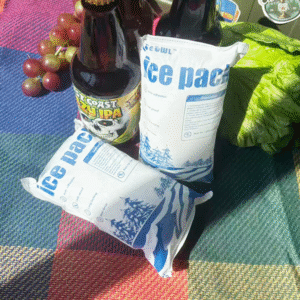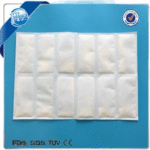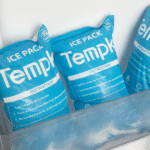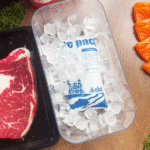Finding near me dry ice packs is crucial when you’re shipping vaccines, seafood or gourmet meals. Dry ice isn’t just ordinary ice; it’s solid carbon dioxide that sublimates at –78.5 °C, providing ultra cold temperatures without leaving puddles. In the fast growing cold chain logistics sector—projected to reach USD 436.30 billion in 2025 and USD 1,359.78 billion by 2034—choosing the right dry ice packs and following best practices can protect quality and reduce costs. This guide walks you through everything from selecting local suppliers to mastering 2025’s smartest shipping techniques, ensuring you’re ready to deliver temperature sensitive goods safely and sustainably.
Why dry ice packs matter: How dry ice compares to traditional ice, including longer cooling times and no water damage, and why local availability matters.
How to choose the right pack near you: Factors like shipment duration, product sensitivity and recommended pounds of dry ice per hour.
Best practices for safe handling and shipping: Personal protective equipment, Belüftung, Lagerung, labeling and the UN 1845 Vorschriften.
Latest trends in 2025: Smart IoT sensors, sustainability initiatives and market growth projections.
FAQs: Answers to common questions such as where to buy dry ice packs near you, how long they last and whether they’re safe for refrigerated goods.
What Makes Dry Ice Packs Essential for Your Cold Chain Needs?
Dry ice packs keep temperatures ultra low without leaks or mess. Unlike water based ice, dry ice sublimates directly to gas at about –78.5 °C. This characteristic allows your pharmaceuticals, biotech samples and gourmet foods to stay cold for extended periods without puddles or water damage. A pound or two of dry ice can maintain a cold environment for up to 24 Std., and recommended amounts vary by shipment type (Z.B., 5–10 lbs per 24 hours for pharmaceuticals).
Erweiterte Erklärung: Because dry ice turns directly into carbon dioxide gas, it doesn’t create moisture that could damage electronics, packaging or labels. The extreme cold means you can achieve sub zero temperatures unreachable by gel packs or ordinary water ice. Zum Beispiel, biotech shipments often need –20 °C to –50 °C and rely on dry ice for consistent cooling. This makes dry ice essential for vaccine distribution and sensitive laboratory samples, especially when long transit times or remote destinations are involved. Local suppliers often offer different sizes of dry ice packs, ensuring you can find the right combination of weight and duration without overpaying or over packing.
Temperature control vs. traditional ice
Dry ice stays colder longer than gel packs or frozen water, meaning fewer replenishments during transit. Traditional ice melts at 0 °C and produces water that can ruin packaging or labels. Dagegen, dry ice’s low temperature and sublimation provide an verlängerte Kühldauer. Außerdem, the absence of water leaks prevents contamination of food or pharmaceuticals. Local suppliers often deliver dry ice in sealed packs that fit inside insulated containers, ensuring consistent cold through transit.
| Versandtyp | Recommended Dry Ice Amount | Versanddauer | Praktische Bedeutung |
| Pharmazeutika | 5–10 lbs per 24 H | 24–72 Stunden | Maintains ultra cold temperatures (–20 °C to –70 °C) for vaccines and biologics. |
| Meeresfrüchte | 1–2 lbs per 24 H | 24 Std. | Keeps seafood at –18 °C to –20 °C without melting ice or water contamination. |
| Biotech -Proben | 5 lbs pro 24 H | 48 Std. | Ensures lab samples stay frozen for research or diagnostics. |
| Food Deliveries | 2–3 lbs per 24 H | 24 Std. | Maintains fresh food between –10 °C and –18 °C for local deliveries. |
Praktische Tipps und Empfehlungen
Match pack size to product sensitivity: Use more dry ice for ultra cold items like vaccines and less for chilled food. Local suppliers often pre package dry ice in various weights.
Verwenden isoliert, belüftete Behälter: A foam cooler or vacuum insulated box slows sublimation and ensures gas can escape safely.
Check local regulations: Some states require labeling dry ice shipments with the weight and the UN 1845 code. Familiarizing yourself with local rules prevents fines and delays.
Real life example: A small biotech firm in San Francisco needed to send blood samples to Los Angeles. By choosing a local supplier of dry ice packs and using 5 lbs per day in a vented foam cooler, the samples arrived at –40 °C within 48 Std.. The lab reported zero temperature excursions, demonstrating the reliability of dry ice for regional transport.
How to Choose the Right Dry Ice Pack Near You?
Selecting the right dry ice pack depends on shipment duration, product sensitivity and container insulation. Für kurze Sendungen (unter 24 Std.), 1–3 lbs per pack may suffice; for pharmaceuticals and long distances, 5–10 lbs per 24 hours are recommended. Always consider the size and weight of your shipment: larger payloads need more ice to offset heat infiltration. Temperature monitoring with IoT sensors can help adjust the quantity mid transport.
Erweiterte Erklärung: Ask yourself: How far are you shipping? What temperature range does your product require? If you’re sending a delicate medical specimen across town, a small pack might be enough. But if you’re transporting a large crate of seafood across the country, you may need multiple packs and a robust insulated container. Modern smart sensors provide real time temperature data, alerting you if the interior warms prematurely. Locally sourced dry ice packs reduce transit time before packaging, preserving more cooling power for your shipment.
Factors to consider when buying dry ice packs
Temperaturempfindlichkeit: Pharmaceutical items often demand –20 °C or colder. Dry ice is ideal for these ultra low temperatures, whereas gel packs suit 2–8 °C refrigerated ranges.
Shipment duration: Longer journeys need more dry ice. In der Regel, zuweisen 1–2 lbs per 24 hours for seafood and 5–10 lbs per 24 hours for pharmaceuticals.
Container insulation: High quality vacuum insulated panels or foam reduce dry ice consumption. Ohne ordnungsgemäße Isolierung, dry ice sublimates faster, raising costs.
Local regulations and airlines: Air shipments often limit dry ice to 200 kg pro Paket, and packages must be vented with visible hazard labels.
Supplier reliability: Choose a supplier known for purity and consistent pack sizes. Local vendors deliver faster, giving you fresher, more potent dry ice.
| Rücksichtnahme | Recommended Approach | Nutzen |
| Dauer | Use formulas like 2 lbs pro 24 h for food or 5–10 lbs per 24 h for ultra cold goods | Prevents under cooling and product spoilage. |
| Isolationsqualität | Select insulated boxes with vented lids | Slows sublimation and allows safe gas release. |
| Einhaltung | Label with “UN 1845” and Class 9 Gefahrenhinweise | Meets regulatory requirements and avoids shipping delays. |
| Überwachung | Integrate IoT temperature sensors | Real time alerts help adjust dry ice or reroute shipments. |
Praktische Tipps und Empfehlungen
Order locally for freshness: Trockeneis sublimiert mit der Zeit; local suppliers minimize transit time, ensuring maximum cooling power on delivery.
Pre condition your cooler: Chill your cooler before packing; this preserves more of the dry ice’s cooling capacity.
Layer properly: Place dry ice at the bottom and goods above, separated by cardboard or foam to prevent freeze damage.
Keep ventilation holes unobstructed: Never tape over the vent holes; gas buildup can rupture the container.
Real life example: A meal kit company in Seattle partnered with a nearby dry ice supplier. By calculating shipments at 2 lbs pro 24 hours and using insulated liners, they reduced spoilage rates by 40%. Adding IoT sensors allowed them to adjust routes when temperature fluctuations occurred, saving thousands of dollars in reimbursement costs.
Safe Handling and Shipping: Best Practices for Dry Ice Packs
Proper handling of dry ice protects your team and your shipment. Always wear insulated gloves and safety goggles when handling dry ice. Avoid direct skin contact and use tongs or towels when transferring dry ice to containers. When transporting, ensure ventilation—carbon dioxide can accumulate and displace oxygen, posing a suffocation risk.
Erweiterte Erklärung: Dry ice is classified under UN 1845, eine Klasse 9 Gefahrgut. It isn’t flammable but releases gas that can pressurize sealed containers and cause asphyxiation. That’s why packaging must be vented: styrofoam boxes or polyethylene containers with vent holes prevent dangerous pressure buildup. Labeling the package with “UN 1845 Dry Ice” and the weight of dry ice is mandatory for air and ground shipments. Special documentation might be needed depending on shipping method, und Gewichtsgrenzen (Zum Beispiel, 200 kg per package on aircraft) must be respected.
Personal protective equipment and handling tips
Use insulated gloves and goggles: Direct contact can cause frostbite. Insulated gloves and eye protection protect you from burns and flying shards.
Vermeiden Sie luftdichte Behälter: Never store dry ice in airtight boxes; gas buildup can cause explosion.
Belüftung sicherstellen: Store dry ice in well ventilated areas to prevent CO₂ accumulation. Avoid placing dry ice in small, enclosed spaces and consider carbon dioxide monitors.
Dispose properly: Allow dry ice to sublimate in a ventilated space. Do not throw it into drains or toilets.
Und 1845 packaging and labeling requirements
Ventilated containers: Packaging must allow gas to escape; styrofoam or polyethylene are common choices.
Hazard labels: Attach the UN 1845 identifier and Class 9 Hazard -Etikett, and include the net weight of dry ice on the package.
Dokumentation: Prepare the necessary dangerous goods declaration for air shipments; ground shipments may have fewer paperwork requirements.
Gewichtsbeschränkungen: Passenger aircraft typically limit dry ice to 200 kg pro Paket. USPS erlaubt nur 2.5 kg for air mail..
Protect the product: Separate goods from dry ice using cardboard or foam to prevent freezing and moisture damage.
| Packaging Aspect | Erfordernis | Warum ist es wichtig |
| Belüftung | Containers must be vented | Prevents pressure buildup and ruptures. |
| Beschriftung | "Und 1845 Dry Ice” label, Klasse 9 hazard symbol, und Gewicht | Ensures carriers know the contents and safety measures. |
| Dokumentation | Dangerous goods declaration for air shipments | Complies with IATA and DOT regulations. |
| Weight Limit | 200 kg für Luftfracht, 2.5 kg for USPS | Helps carriers manage cabin ventilation and safety. |
Praktische Tipps und Empfehlungen
Trainiere dein Team: Provide regular safety training on handling dry ice and emergency preparedness, including signs of carbon dioxide exposure (dizziness, shortness of breath).
Inspect packaging: Check for cracks or loose lids before shipping; replace any compromised containers.
Überwachen Sie die Temperatur: Use IoT sensors to track temperature and humidity; alerts can signal if dry ice is sublimating too quickly.
Have an emergency plan: Know how to respond if a container leaks or if a person experiences carbon dioxide exposure. Move to a ventilated area and seek medical attention if symptoms appear.
Real life example: A pharmaceutical distributor in Chicago implemented UN 1845 training and equipped workers with insulated gloves and CO₂ monitors. In one incident, a worker noticed a rapid temperature rise in an enclosed loading bay; the monitor signaled high CO₂ levels, prompting immediate evacuation. The quick response prevented injuries and demonstrated the importance of monitoring and training.
Trends and Innovations in 2025: Intelligente Verpackungen, Sustainability and Market Growth
Cold chain logistics is booming and evolving rapidly. The global cold chain logistics market, geschätzt bei USD 436.30 billion in 2025, is predicted to exceed USD 1,359.78 billion by 2034. Technological innovation is driving this growth, with dry ice taking the largest market share (55.16% of the technology segment in 2024). Sustainability and digital transformation are also reshaping the industry: smart packaging with IoT sensors and eco friendly materials are no longer optional but expected.
Trendübersicht
The landscape for “near me dry ice packs” is shaped by several trends:
Smart IoT monitoring: Integrating sensors into dry ice packs and containers allows real time tracking of temperature and humidity, sending alerts when conditions drift. This reduces spoilage and ensures compliance.
Nachhaltige Verpackung: Companies are adopting biodegradable and reusable materials to reduce waste and carbon footprints. Nordic Cold Chain Solutions, Zum Beispiel, introduced drain friendly gel packs that can be reused or safely disposed.
Automation and AI: AI is automating route optimization, compliance monitoring and anomaly detection in cold chain logistics. Automated packing lines ensure consistent dry ice placement and minimize human error.
Market expansion: Asia Pacific is projected to grow at 14.76% CAGR between 2025 Und 2034, driven by investments in cold chain infrastructure and growing demand for frozen foods. Europe leads the cold chain packaging refrigerants market with a 31.85% share.
Regulatory tightening: Food safety laws and UN 1845 updates emphasize accurate labeling and safe packaging. This promotes widespread adoption of best practices and fosters trust among consumers and regulators.
Neueste Entwicklungen auf einen Blick
IoT Enabled Dry Ice Packs: Many suppliers now embed sensors that measure temperature, Luftfeuchtigkeit und Standort, enabling businesses to monitor conditions in real time and adjust routes.
Eco Friendly Refrigerants: The cold chain packaging refrigerants market is projected to grow from USD 1.69 billion in 2025 to USD 2.92 Milliarden von 2032, with innovations focusing on biodegradable and drain friendly gel packs.
AI Route Optimization: Cold chain providers are using AI to analyze traffic patterns and weather to optimize delivery routes, reducing fuel consumption and maintaining stable temperatures.
Regional Investment: Asia Pacific’s cold chain logistics market is expected to reach USD 663.62 Milliarden von 2034 due to government investment and the rising middle class demanding frozen foods.
Markteinsichten
Global cold chain logistics growth is fueled by rising demand for pharmaceuticals and frozen foods. Trockeneis, capturing more than half of the technology segment, remains essential for ultra cold shipments. In der Zwischenzeit, gel packs and phase change materials cater to refrigerated goods (2–8 ° C). Europe’s 31.85% share of the cold chain refrigerants market underscores the region’s advanced infrastructure and strong food exports. Jedoch, high costs and environmental concerns are obstacles, prompting innovation toward reusable packaging and eco friendly refrigerants. With the world population projected to reach 9.7 Milliarden von 2050, reliable cold chain solutions will become even more critical.
FAQ
Where can I buy dry ice packs near me? Check local grocery stores, welding supply companies or specialized cold chain suppliers. Many local vendors deliver dry ice on the same day, ensuring maximum freshness and cooling power.
Wie lange dauern Trockeneisbeutel in einem Kühler?? A 5 lb pack typically lasts 24–48 hours in a well insulated container. Factors like ambient temperature and insulation quality can shorten or extend this timeline.
Are dry ice packs safe for refrigerated items (2–8 ° C)? Dry ice maintains sub zero temperatures and will freeze items. For refrigerated goods like vaccines requiring 2–8 °C, use gel packs or phase change materials instead.
What safety gear is required to handle dry ice? Always wear insulated gloves and safety goggles. Avoid direct contact and handle dry ice with tongs or towels.
Why must dry ice packages be vented? Dry ice sublimates into carbon dioxide gas that can build up pressure and cause containers to explode. Venting and proper labeling prevent hazardous pressure buildup.
How should I dispose of unused dry ice? Allow it to sublimate in a ventilated area at room temperature. Never dispose of dry ice in sinks or toilets, as the gas can damage plumbing.
Do airlines restrict dry ice shipments? Ja. Passenger aircraft often limit dry ice to 200 kg pro Paket, and USPS permits only 2.5 kg per parcel. Check airline and postal guidelines before shipping.
Kann trocknen Eis wiederverwendet werden? Once dry ice sublimates, it cannot be refrozen. Jedoch, reusable insulated containers and gel packs offer eco friendly alternatives. New innovations include drain friendly gel packs that can be reused or disposed responsibly.
Zusammenfassung und Empfehlungen
In 2025, near me dry ice packs remain indispensable for ultra cold shipping. Dry ice sublimates at –78.5 °C, providing long lasting cooling without water damage. Choosing the right pack requires matching product sensitivity and shipment duration, with typical recommendations ranging from 1–2 lbs per 24 hours for food Zu 5–10 lbs per 24 hours for pharmaceuticals. Proper handling—wearing insulated gloves, venting containers and labeling packages with UN 1845—ensures safety and compliance. Emerging trends like smart sensors and eco friendly packaging illustrate how technology and sustainability are reshaping the cold chain market. With the global cold chain logistics market expected to reach USD 1,359.78 billion by 2034, mastering these practices today prepares you for tomorrow’s growth.
Umsetzbarer Rat
Bewerten Sie Ihre Bedürfnisse: Determine whether your shipment requires ultra cold or refrigerated temperatures and choose dry ice or gel packs accordingly.
Source locally: Contact suppliers near you for fresh dry ice, and ask about different pack sizes and delivery options.
Invest in smart monitoring: Use IoT sensors to track temperature and humidity, ensuring you can adjust routes or dry ice quantities in real time.
Adopt sustainable solutions: Explore reusable containers and eco friendly refrigerants; these options cut waste and meet regulatory expectations.
Bleib informiert: Follow UN 1845 updates and local regulations to ensure compliance when shipping dry ice.
Über Tempk
Tempk ist ein führender Anbieter von Kühlkettenlösungen, providing dry ice packs, Gelpackungen, insulated containers and smart packaging technologies. Our products are designed to ensure optimal temperature control, regulatory compliance and sustainability for pharmaceuticals, food and biotech industries. With research and development focused on eco friendly materials and IoT integration, we help you deliver your temperature sensitive goods safely and efficiently.
Benötigen Sie Expertenberatung? Consult with our team to design a tailored cold chain strategy, from choosing the right dry ice packs to implementing smart monitoring solutions. Contact us today to keep your products safe, compliant and on time.
























